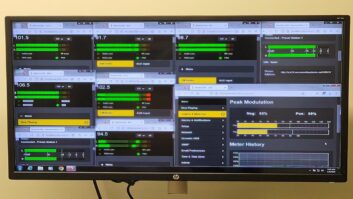Dan Houg is station engineer for KAXE(FM) in Grand Rapids and KBXE(FM) in Bagley/Bemidji, Mich. He wanted to add temperature monitoring to his main KAXE transmitter; here’s how the project went.
He sought to avoid components made of plastic because they could be melted in the stack exhaust. He located a Sunpro gauge sender and capillary tube assembly made of metal at a local farm-and-fleet store. Amazon also sells it, for under $25. Search for “Sunpro CP7975 Mechanical Water Temperature Gauge – Black.” Similar units can be found at any auto supply store.
A benefit of this kind of sensor is that you’re not working with small wire pieces or hardware above the tube cavity opening on top of the transmitter.
With that in mind, and worried that plastic zip ties might melt, Dan didn’t secure the sensor but just laid it on top of the exhaust port of the transmitter, as seen in Fig. 1. The second photo shows the sender cable coiled above the transmitter and connected to the temperature gauge.

Fig. 1: The temperature sensor is placed over the transmitter exhaust air grate.

Fig 2: The interconnecting cable is coiled atop the transmitter and needs no plastic tie-wraps.
Monitoring stack temperature while tuning the transmitter is an excellent indicator of final efficiency. As the tube’s efficiency lowers, an increase in temperature (heat) results, which can be read off the temperature gauge. Put the meter right next to the output power meter (Fig. 3) for convenience in making the correlation.
Dan added a Taylor thermometer powered by a AAA cell (which he prefers to a “watch cell” because a AAA lasts several years). He stuck the Taylor room thermometer to the equipment rack to monitor the shack temperature.

Fig 3: You can easily compare the correlation between temperature and transmitter efficiency by locating the temperature meter near the transmitter PA meters.

Fig. 4: A battery-operated Taylor thermometer monitors the transmitter shack temperature.
Dan writes that, just for grins, he placed the Taylor sender unit over the tube exhaust for a few moments; but the air temperature was higher than the 158 degree F limit for this particular Taylor model. But again, any sort of plastic over the tube exhaust is asking for a nasty meltdown. Stick with the automotive thermometer!
Dan Houg is relatively new to radio engineering but comes from a background of tinkering with electronics and automotives.
The automotive water temperature assembly is just one noteworthy item he’s added at the station. Another is an inexpensive backup audio device he made using a Broadcast Tools Silence Monitor III Plus and an industrial MP3 player that is activated on a contact closure from the SM-III. Although there are commercial products that do the same thing, Dan’s budget-saving approach has been useful during periods of automation hang-ups.
* * *
Broadcast engineering is a science that runs on the laws of physics. But there are other laws governing the operation of a radio station, and they are equally powerful.
Frank Grundstein, CBRE, CBNT, director of sales for manufacturer Logitek (www.logitekaudio.com), has gathered such laws through his years living on the Engineering Planet. Here are a few:
-A pat on the back is only a few centimeters from a kick in the pants.
-If it happens, it must be possible.
-It works better if you plug it in.
-Nothing is impossible for the man who doesn’t have to do the work.
-A theory is better than its explanation.
-The amount of work done varies inversely with the amount of time spent in the office.
-Nothing is ever a complete failure; it can always serve as a bad example.
-The first 90 percent of the project takes 90 percent of the time, and the last 10 percent takes the other 90 percent.
-Everything goes wrong at once.
-The obvious answer is always overlooked.
-There is always an easy answer to every problem: neat, plausible and wrong.
-Anything that begins well will end badly. (Note: The converse of this law is not true.)
-If the facts do not conform to the theory, they must be disposed of.
-Everyone has a scheme that will not work.
-Make three correct guesses consecutively and you will establish yourself as an expert.
-The probability of a given event occurring is inversely proportional to its desirability.
-If it can find a way to wear out faster, it will.
-If a project is not worth doing, it is not worth doing well.
-The more time you spend in reporting on what you are doing, the less time you have to do anything. Stability is achieved when you spend all your time reporting on the nothing you are doing.
-Inside every large problem is a small problem struggling to get out.
-Negative expectations yield negative results. Positive expectation yield negative results.
-Work expands to fill the time available for its completion.
-The other line moves faster.
If you’d like your own copy of the “Laws” to print out and post in your shop, email Frank Grundstein. Thanks, Frank, for sharing a lighter (but so true) side to our profession.
Contribute to Workbench! You’ll help your fellow engineers and qualify for SBE recertification credit. Send Workbench tips to [email protected]. Fax to (603) 472-4944.
Author John Bisset has spent 43 years in the broadcasting industry and is still learning. He works for Tieline Technology, is SBE certified and is a past recipient of the SBE’s Educator of the Year Award.












